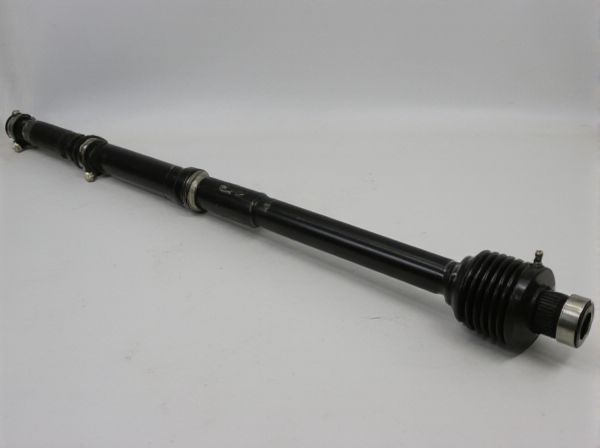
Photo illustration: Telescopic Shaft vs Non-telescopic Shaft
Telescopic shafts offer adjustable length, allowing better flexibility and compact storage, making them ideal for applications with varying distances. Non-telescopic shafts are fixed in length, providing simpler construction and higher durability for consistent, heavy-duty use. Your choice depends on whether you prioritize adaptability or robustness in the shaft design.
Table of Comparison
| Feature | Telescopic Shaft | Non-Telescopic Shaft |
|---|---|---|
| Design | Adjustable length with sliding segments | Fixed length, solid shaft |
| Flexibility | Accommodates movement and length changes | Rigid, limited flexibility |
| Use Case | Ideal for vehicles with variable suspension travel | Suitable for fixed-length driveshaft requirements |
| Durability | Higher wear due to moving parts, requires maintenance | More durable with fewer components |
| Cost | Generally more expensive | Lower cost, simpler construction |
| Weight | Typically heavier due to extra components | Lighter, fewer parts |
| Performance | Better in dynamic conditions with suspension movement | Optimal for steady, unchanging drivetrain setups |
Introduction to Shaft Types: Telescopic vs Non-telescopic
Telescopic shafts consist of multiple nested tubes that extend and retract, allowing for adjustable length and enhanced flexibility in applications such as automotive drive systems and agricultural machinery. Non-telescopic shafts are rigid, single-piece components designed for fixed-length power transmission, providing high strength and durability in constant-distance setups. Choosing between telescopic and non-telescopic shafts depends on the need for variability in length, load capacity, and operational environment.
Core Functionality and Design Differences
Telescopic shafts consist of multiple sliding segments allowing adjustable length and smooth transmission of torque in varying distances, enhancing flexibility in machinery such as agricultural equipment and vehicles. Non-telescopic shafts feature a fixed, rigid design optimized for consistent length and straightforward power transmission where no length adjustment is necessary. The core functionality of telescopic shafts lies in their ability to absorb shocks and accommodate movement, while non-telescopic shafts prioritize simplicity and durability in stable operating conditions.
Material Composition and Structural Integrity
Telescopic shafts typically feature multi-layered steel or aluminum alloys designed for flexibility and telescoping motion, enhancing impact absorption and structural adaptability. Non-telescopic shafts are commonly constructed from single-piece high-strength steel or carbon fiber composites, emphasizing rigidity and maximum load-bearing capacity. The material composition in telescopic shafts prioritizes elasticity and energy dissipation, whereas non-telescopic shafts focus on maximizing structural integrity and resistance to deformation under constant stress.
Installation and Adjustment Flexibility
Telescopic shafts offer superior installation flexibility due to their adjustable length, allowing for precise fitting in varying machinery layouts without extensive modifications. Non-telescopic shafts have fixed lengths that require exact measurements and may necessitate additional components or adjustments during installation. The ability to easily adjust telescopic shafts on-site reduces downtime and simplifies maintenance compared to the rigid nature of non-telescopic shafts.
Performance in Varied Applications
Telescopic shafts provide superior flexibility and adaptability in performance across varied applications by allowing adjustable length and absorbing torque fluctuations, which reduces vibration and enhances operational efficiency. Non-telescopic shafts offer consistent strength and rigidity, ideal for applications requiring fixed-length power transmission with minimal axial movement. Performance optimization depends on the specific use case, where telescopic shafts excel in dynamic environments such as agricultural machinery, and non-telescopic shafts perform reliably in steady, uniform power transfer scenarios.
Maintenance Requirements and Longevity
Telescopic shafts require regular inspection and lubrication to maintain their sliding components and prevent corrosion, ensuring smooth extension and retraction. Non-telescopic shafts generally have simpler maintenance needs, as their solid design reduces vulnerability to dirt infiltration and wear but still requires routine checks for balancing and bearing wear. Longevity of telescopic shafts depends heavily on proper sealing and maintenance, while non-telescopic shafts often offer longer service life under moderate conditions due to their robust, fixed structure.
Cost Considerations and Value Assessment
Telescopic shafts typically incur higher initial costs due to their complex design and enhanced functionality, offering variable length adjustment for improved performance and space efficiency. Non-telescopic shafts, with simpler construction and fixed length, present lower upfront expenses but may lack adaptability, potentially leading to increased maintenance or replacement costs over time. Evaluating lifecycle value requires balancing the premium price of telescopic shafts against long-term savings from reduced wear and adaptable fit in dynamic applications.
Safety Features and Operational Risks
Telescopic shafts enhance safety by allowing adjustable length, reducing the risk of shaft misalignment and damage during operation, and often incorporate protective guards to prevent accidental contact. Non-telescopic shafts, being fixed-length, pose higher operational risks such as increased chances of shaft bending or breakage under load, and may lack adequate shielding, raising the potential for injury. Proper maintenance and adherence to manufacturer safety guidelines are crucial for both types to mitigate hazards and ensure reliable performance.
Industry Use Cases and Preferences
Telescopic shafts are preferred in industries requiring variable length adjustments and compact storage, such as agricultural machinery and construction equipment, due to their flexibility and ease of maintenance. Non-telescopic shafts, favored in automotive and industrial power transmission, offer superior torque capacity and structural rigidity for stable, high-performance applications. Industry preferences hinge on operational demands, with telescopic shafts excelling in dynamic length applications and non-telescopic shafts dominating scenarios needing consistent, heavy-duty power transfer.
Choosing the Right Shaft for Your Needs
Telescopic shafts offer adjustable length and enhanced flexibility, making them ideal for applications requiring variable reach and compact storage. Non-telescopic shafts provide fixed, robust performance better suited to consistent, heavy-duty tasks with minimal maintenance needs. Choosing the right shaft depends on balancing the need for adjustability against strength and durability requirements specific to your project or equipment.
 caratoz.com
caratoz.com